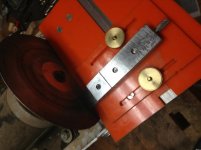John Allan
Aluminum
- Joined
- Jan 29, 2011
- Location
- North Central Arkansas
About 3 years ago I bought a 12 x 30 Nardini lathe that needed a LOT of work. I finished the electrics and got it turning, then fixed the mechanicals to make it work and feed. Now came the accuracy.
I attended Richards scraping class in Ohio last year to help develop the knowledge and skills I needed to scrape in my Nardini. After using the Glendo at the class I realized that the sharpening that I was doing at home was stone age.
The pictures show the result of my efforts. The dog driver shown has a 6” "Ebay" diamond disc secured to it. The working surface is clamped onto a spacer having a 5 degree angle. Below is a tray with an absorbent material to protect the lathe. So far the results are great. I have been running the 3000 grit finishing disc at about 350 RPM. Finish is good and splashing and cleanup of the WD40 lube is minimal.
One tip I picked up in Richards class was the use of clear packaging tape to transfer the bluing pattern on you wok, to a sheet of paper. Between my old eyes and the poor lighting in my shop, this has been a big help in seeing the results of my work.
John
I attended Richards scraping class in Ohio last year to help develop the knowledge and skills I needed to scrape in my Nardini. After using the Glendo at the class I realized that the sharpening that I was doing at home was stone age.
The pictures show the result of my efforts. The dog driver shown has a 6” "Ebay" diamond disc secured to it. The working surface is clamped onto a spacer having a 5 degree angle. Below is a tray with an absorbent material to protect the lathe. So far the results are great. I have been running the 3000 grit finishing disc at about 350 RPM. Finish is good and splashing and cleanup of the WD40 lube is minimal.
One tip I picked up in Richards class was the use of clear packaging tape to transfer the bluing pattern on you wok, to a sheet of paper. Between my old eyes and the poor lighting in my shop, this has been a big help in seeing the results of my work.
John






